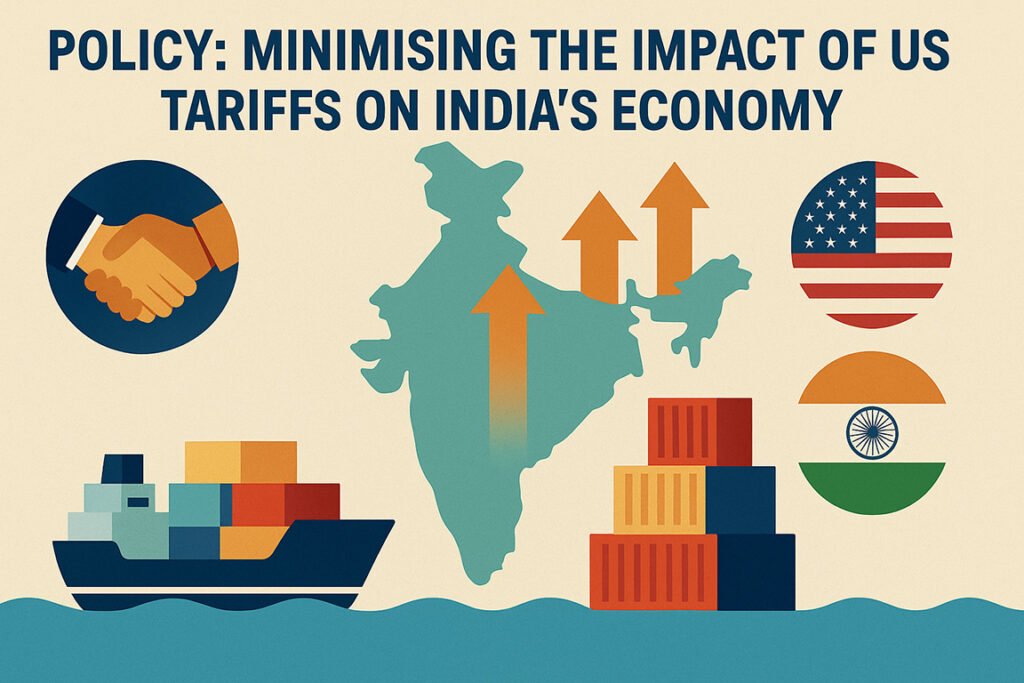
Policy Note: Strategies for Minimising the Impact of US Tariffs on India’s Economy
The imposition of tariffs by the United States on select imports poses both immediate risks and long-term challenges for India’s export-oriented growth. Given the United States’ role as India’s largest single export destination, tariff escalation can disrupt key sectors, weaken competitiveness, and affect employment. This note outlines a comprehensive set of policy measures that India can adopt to mitigate these risks and build resilience.
1. Diplomatic Engagement and Trade Negotiations
The foremost step in minimising the adverse effects of US tariffs is robust diplomatic engagement. India should pursue targeted negotiations with the United States Trade Representative (USTR) to secure product-level exclusions, higher de minimis thresholds, and phased tariff rollouts for sensitive goods. Restoring preferential trade arrangements akin to the Generalized System of Preferences (GSP) must be prioritised, especially for labour-intensive sectors such as textiles, gems and jewellery, and leather. Furthermore, India should expand Mutual Recognition Agreements (MRAs) in testing and certification, reducing non-tariff barriers that often compound the impact of tariffs. Retaliatory duties, if deployed, must remain narrow, WTO-consistent, and time-bound to maintain constructive relations.
2. Diversification of Export Markets
Reducing over-dependence on the US market is a structural priority. India should accelerate the conclusion and implementation of Free Trade Agreements (FTAs) and Comprehensive Economic Partnership Agreements (CEPAs) with the EU, UK, and GCC countries. These pacts should extend beyond tariff reduction to include regulatory cooperation and investment facilitation. At the same time, services exports—such as IT, remote healthcare, consulting, and education—should be scaled up, as they remain immune to tariff regimes. Branding and direct-to-consumer (D2C) strategies in global e-commerce platforms can further protect Indian exporters’ margins and reduce intermediary costs.
3. Supply Chain Reconfiguration
Reconfiguring supply chains is critical to reducing the effective incidence of tariffs. India must encourage firms to utilise US Foreign-Trade Zones (FTZs), bonded warehouses, and regional assembly hubs in Mexico and Canada, which qualify under USMCA rules of origin. Such strategies would allow Indian products to enter the US market with lower duties. In addition, tariff engineering—through product redesign and reclassification—offers scope to legally reduce exposure to higher duty brackets. Domestically, rationalising import duties on critical intermediates and reducing logistics bottlenecks will enable exporters to price competitively even under adverse tariff conditions.
4. Upgrading the Export Basket
To ensure long-term resilience, India must transition from commodity-based exports to high-value, technology-intensive products. This involves fostering industries in specialty chemicals, medical devices, auto electronics, and engineering subsystems. Production-Linked Incentive (PLI) schemes should explicitly reward export sophistication and value addition, rather than simply encouraging scale. Alongside this, India should strengthen its quality infrastructure by expanding accredited laboratories, improving traceability systems, and aligning with international labour and environmental standards. These measures will enhance compliance, reduce detentions, and safeguard India’s global reputation.
5. Cost Reduction through Logistics and Trade Finance
Improving cost competitiveness can substantially offset the burden of tariffs. India must prioritise the full operationalisation of the Dedicated Freight Corridors (DFCs), expansion of port modernisation, and digitalisation of customs procedures. The adoption of 24×7 customs operations and single-window clearance will reduce delays and enhance predictability. On the financial side, expanding concessional trade finance through EXIM Bank and the Export Credit Guarantee Corporation (ECGC) is essential, particularly for small and medium enterprises. Increased access to foreign exchange hedging instruments and reduced duties on energy-intensive inputs will further support exporters’ ability to absorb tariff shocks.
6. Sector-Specific Policy Interventions
Targeted responses at the sectoral level are indispensable. In pharmaceuticals, the focus should shift toward complex generics, injectables, and biosimilars, supported by continuous USFDA compliance. In textiles and apparel, India must invest in man-made fibre production, enhance traceability in cotton, and explore final-stage processing in Mexico to leverage USMCA. The electronics and electric vehicle (EV) supply chains require deeper localisation of components such as printed circuit boards (PCBs) and magnets. Gems and jewellery exporters should pivot toward lab-grown diamonds and design-led products, supported by bonded re-export zones. Such tailored interventions will ensure resilience across India’s most vulnerable export categories.
7. Firm-Level Preparedness
While policy support is crucial, exporters themselves must adopt proactive measures. Firms should map their product portfolios against tariff risks by HS codes and simulate cost implications. Obtaining trusted-trader certifications such as Authorised Economic Operator (AEO) and C-TPAT will minimise compliance costs at US borders. Pre-filing tariff classifications with US Customs can prevent costly disputes, while export contracts should include tariff-linked price adjustment clauses. Finally, firms should establish real-time dashboards integrating data from DGFT, ICEGATE, and USTR updates, enabling timely decision-making.
8. A Time-Bound Roadmap
A phased roadmap is essential for effective execution.
- Short-term (0–3 months): Secure tariff exclusions, reduce domestic duties on intermediates, and implement bonded warehouse and FTZ utilisation.
- Medium-term (3–18 months): Conclude MRAs, initiate nearshoring pilots in Mexico and Canada, expand trade finance schemes, and operationalise export-quality labs.
- Long-term (18–36 months): Finalise major FTAs, restructure the export basket toward high-complexity products, and institutionalise an “Export Complexity + Logistics Cost” index to guide incentive frameworks.
Conclusion
US tariffs, while disruptive, need not derail India’s export ambitions. A strategic combination of diplomacy, diversification, supply-chain redesign, cost reduction, and industrial upgrading can transform this challenge into an opportunity. By institutionalising resilience in its trade policy and industrial strategy, India can not only mitigate tariff shocks but also accelerate its transition toward a more competitive, diversified, and value-driven export economy.